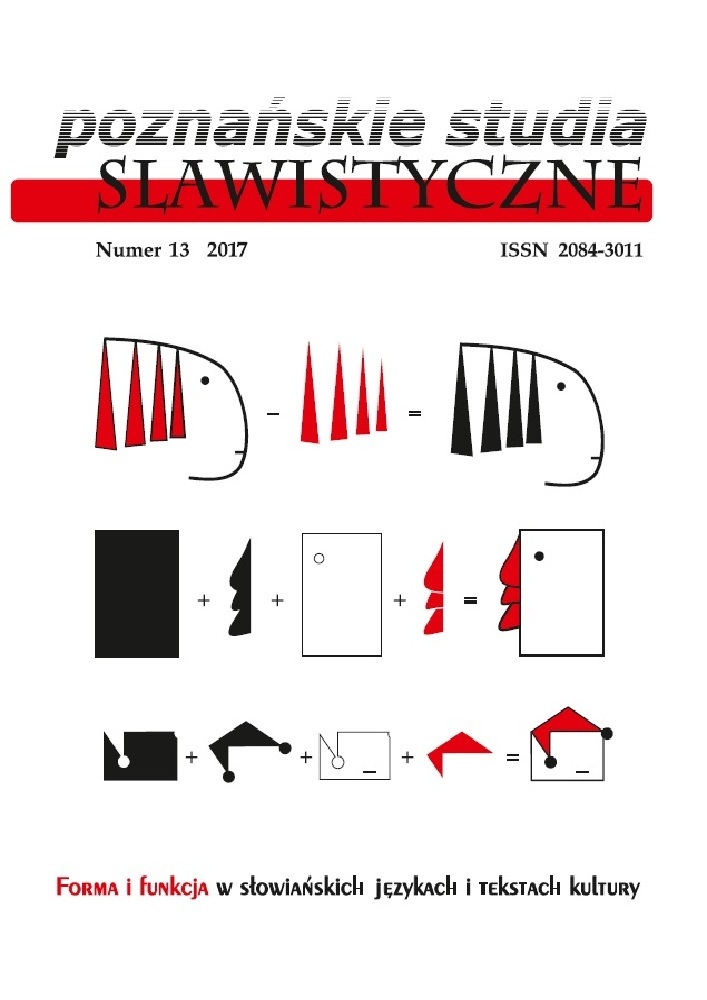Abstrakt
The paper addresses the problem of mutual relation between form and function as exemplified by haiku. Focusing upon the structure of haiku conducive to epiphany, it discusses some general aspects, independent of the differences between Eastern and Western varieties of the form. The “literariness” of the genre is demonstrated with reference to dimensions of imagery (as defined in Langacker’s model of cognitive grammar), and to the strongly metonymic character of haiku. Finally, some shortcomings of “Polish haiku” are shown as a function of its culture-bound untranslatability.Bibliografia
Balcerzan, E. (2013). Literackość. Toruń: Wydawnictwo Naukowe Uniwersytetu im. Mikołaja Kopernika.
Bedlicki, M. (2014). [sierpniowe dni]. Z konkursu Wakai Haiku 2014. http://haikupokonkursowe.blogspot.com/. 19.07.2016.
Drozdowicz, M. (2014). Recenzja książki Piotra Sawickiego i Jitki Smičekovej pt. Srovnávací frazeologie a paremiografie. Vybrané studie ze slovanských a románských jazyků / Frazeologia i paremiografia porównawcza. Wybrane studia z zakresu języków słowiańskich i romańskich. Ostrava 2010. „Academic Journal of Modern Philology”, vol. 3, s. 163–168.
Gurga, L. (2003). Haiku – The Poetry of the Seasons. W: L. Gurga. Haiku: A Poet’s Guide. Illinois: Modern Haiku Press, s. 1–3. http://bliskohaiq.blogspot.com/2013/07/definicja-haiku.html. 19.07.2016.
Henderson, H. (1958). An Introduction to Haiku, an Anthology of Poems and Poets from Basho to Shiki. New York: Doubleday.
Hiraga, M. (1999). Blending and an Interpretation of Haiku: A Cognitive Approach. „Poetics Today”, vol. 20, nr 3, s. 461–481.
Hiraga, M. (2003). How metaphor and iconicity are entwined in poetry: a case in Haiku. W: From sign to signing. Red. W.G. Muller, O. Fischer. Amsterdam–Philadelphia: John Benjamins.
Humphrey, L., Bradley, J., Somers, A., Gilpin, G. (2011). The Little Book of Transcreation. London: Mother Tongue Ltd.
Izutsu, T. (2001). Haiku jako wydarzenie egzystencjalne. Przeł. A.J. Nowak. „Teksty Drugie”, nr 1(66), s. 191–202.
Jakobson, R. (1960). Poetyka w świetle językoznawstwa. Przeł. K. Pomorska. Wrocław: Ossolineum.
Jarniewicz, J. (2015). Literary Translation. W: Ways to Translation. Red. Ł. Bogucki, S. Goźdź-Roszkowski, P. Stalmaszczyk. Łódź: Wydawnictwo Uniwersytetu Łódzkiego, s. 227–248.
Kowalska, T. (2002). Japońska poezja haiku. „Gazeta Uniwersytecka UŚ”, wydanie specjalne, maj. gazeta.us.edu.pl. 2.11.2016.
Kwiatkowska, A. (1999). A Cognitive Linguist Reads Haiku Poetry. W: Cognitive Perspectives on Language. Red. B. Lewandowska-Tomaszczyk. Frankfurt am Main: Peter Lang, s. 187–197.
Langacker, R.W. (2005). Obserwacje i rozważania na temat zjawiska subiektyfikacji. Przeł. M. Majewska. Kraków: Universitas.
Langacker, R.W. (2009). Gramatyka kognitywna. Wprowadzenie. Przeł. E. Tabakowska, M. Buchta, H. Kardela, W. Kubiński, P. Łozowski et al. Kraków: Universitas.
Michałowski, P. (1999). Haiku. W: Miniatura poetycka, Szczecin: Wydawnictwo Uniwersytetu Szczecińskiego.
Miller, P. (red.) (2016). Modern Haiku. „An Independent Journal of Haiku and Haiku Studies”, vol. 47. Miłosz, C. (1992). Haiku. Kraków: Wydawnictwo M.
Mitsui, R. (2005). O stawie i żabie. „Polonia Japonica”. http://www.polonia-jp.jp/index.php/literaturajp/item/641-o-stawie-i-zabie. 15.12.2015.
Nangia, S. (2013). What makes pierre fréha’s french sahib a novel of globalization?: reflections of a translator. „Folia linguistica et litteraria”, nr 7, s. 189–196.
Śniecikowska, B. (2009). Obrazowość jako wyznacznik haiku – na przykładzie polskich kontynuacji i imitacji gatunku. W: Między obrazem a tekstem. Red. A. Kwiatkowska, J. Jarniewicz. Łódź: Wydawnictwo Uniwersytetu Łódzkiego, s. 131–147.
Śniecikowska, B. (2012). Figure/ground sensory segregation in Japanese and nonOriental haiku. W: Texts and Minds. Papers in Cognitive Poetics and Rhetoric. Red. A. Kwiatkowska. Frankfurt am Main: Peter Lang, s. 139–154.
Śniecikowska, B. (2014). Poezja uważności – Czesław Milosz i haiku. „Zagadnienia Rodzajów Literackich”, nr LVII, z. 1, s. 9–26.
Śniecikowska, B. (2015). Oryginały czy imitacje? Wokół „najprawdziwszych” polskich haiku. „Pamiętnik Literacki”, nr 2, s. 139–176.
Vieira, E.R.P. (1999). Liberating Calibans. Readings of Antropofagia and Haroldo de Campos’ Poetics of Transcreation. W: Post-Colonial Translation. Theory and Practice. Red. S. Bassnett, H. Trivedi. London–New York: Routledge, s. 95–113.
Wojda, D. (2013). Przyrządzanie wizerunku Murzyna w antologii „Niam niam” Edwarda Kozikowskiego i Emila Zegadłowicza. „Przestrzenie Teorii”, z. 19, s. 77–94.
https://doi.org/10.14746/pt.2013.19.5
Żuławska-Umeda, A. (red.) (2006). Haiku. Bielsko-Biała: ELAY. https://pl.wikipedia.org./wiki/Haiku. 19.07.2016.
Haiku Topics, Theory and Keywords. https://haikutopics.blogspot.com/2006/06/kireji.html. 15.12.2015. https://www.wykop.pl/wpis/22381687/stara-sadzawka-zabaskok-plusk-to-jest-slnnywiers/. 21.07.2016.
London Translation. http://www.londontranslation.co.uk/faq/basics/transcreation/. 19.07.2016.
Polski Portal Literacki. http://www.poezja.org/wiersz,11,19353.html. 15.12.2015.
Strona internetowa agencji tłumaczeniowej Skrivanek. http://www.skrivanek.pl/pl/aktualnosci/artykuly-eksperckie/transkreacja-czy-zwykle-tlumaczenie.aspx. 15.12.2015.
Licencja

Utwór dostępny jest na licencji Creative Commons Uznanie autorstwa – Bez utworów zależnych 4.0 Międzynarodowe.
